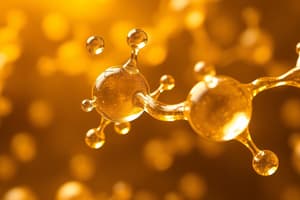Podcast
Questions and Answers
What type of reaction is used to assemble biological macromolecules?
What type of reaction is used to assemble biological macromolecules?
- Hydrolysis
- Reduction
- Dehydration synthesis (correct)
- Oxidation
Why do saturated fatty acids tend to be solid at room temperature?
Why do saturated fatty acids tend to be solid at room temperature?
- Due to the presence of double bonds
- Because they are hydrophilic
- They contain bent molecules
- They can pack closely together due to straight molecules (correct)
What feature makes unsaturated fatty acids fluid at room temperature?
What feature makes unsaturated fatty acids fluid at room temperature?
- Formation of a bilayer in water
- Connecting amino acids
- Being hydrophobic
- Presence of double bonds (correct)
Which component of phospholipids is hydrophobic?
Which component of phospholipids is hydrophobic?
What type of bond connects amino acids in proteins?
What type of bond connects amino acids in proteins?
Which level of protein structure is a consequence of interactions between R-groups, resulting in a complex three-dimensional shape?
Which level of protein structure is a consequence of interactions between R-groups, resulting in a complex three-dimensional shape?
What is the basis for all cellular membranes, creating a hydrophobic barrier to diffusion between aqueous compartments?
What is the basis for all cellular membranes, creating a hydrophobic barrier to diffusion between aqueous compartments?
What type of bonds primarily hold proteins together, allowing them to change shape under different conditions?
What type of bonds primarily hold proteins together, allowing them to change shape under different conditions?
Which type of molecules can pass through the semipermeable phospholipid bilayer of cellular membranes?
Which type of molecules can pass through the semipermeable phospholipid bilayer of cellular membranes?
What are the consequences of hydrogen bonding between carboxyl and amino groups along a polypeptide backbone?
What are the consequences of hydrogen bonding between carboxyl and amino groups along a polypeptide backbone?
Flashcards are hidden until you start studying




